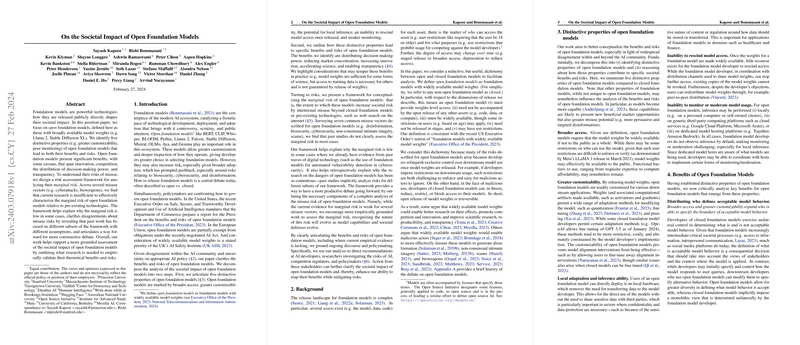On the Societal Impact of Open Foundation Models
The paper "On the Societal Impact of Open Foundation Models" examines the implications of open foundation models whose weights are publicly available, such as Llama 2 and Stable Diffusion XL. The authors categorize the societal consequences into benefits and risks, attempting to strike a balance between them through a nuanced framework.
Distinctive Properties
Five distinctive properties of open foundation models are identified:
- Broader Access: These models are characterized by the wide availability of weights, facilitating greater inclusivity in usage.
- Greater Customizability: Users can modify these models for specific applications due to open access to weights.
- Local Adaptation and Inference: These models can run locally, circumventing the necessity to share data with external servers.
- Irrevocability of Access: Once released, access to model weights cannot be revoked, raising potential misuse concerns.
- Weaker Monitoring: Monitoring usage is challenging, especially for local instances.
Benefits
The paper articulates several benefits derived from these properties:
- Distributing Decision-Making Power: Open models allow for a more decentralized determination of acceptable behavior, diversifying perspectives and applications.
- Innovation and Competition: The accessibility of open models accelerates new use cases and market innovation, though this must be weighed against the potential for model fragmentation and the comparative advantages of closed models in improvement and feedback.
- Scientific Research: Open models enhance reproducibility and inclusion in research, though the complete benefits hinge on access to data and other assets beyond weights.
- Transparency: Open models permit greater scrutiny and accountability, particularly pertinent given historic opacity in digital technologies.
- Mitigating Market Concentration: By enabling smaller entities to compete, open models could distribute market power more evenly.
Risks
The authors provide a framework to assess the societal risks of open foundation models, emphasizing the marginal risk:
- Misuse Vectors: The risks are articulated across vectors such as cybersecurity, biosecurity, disinformation, and other forms of social harm.
- Marginal Risk Framework: This framework assesses whether these models increase societal risk relative to pre-existing technologies or closed models and considers the existing defenses and their potential efficacy against newly introduced risks.
Evidence and Analysis
The paper's strength lies in its structured approach to risk assessment, although it acknowledges the current insufficiency of data in several areas. The framework aims to stimulate precise discourse on the marginal risks of open models, contrasting with pre-existing risks from other technologies.
Recommendations
The paper concludes with targeted recommendations:
- AI Developers: Transparency and clear delineation of responsibility for safe and responsible use are critical.
- Risk Researchers: Further empirical work is needed to elucidate the nuanced balance of risks and benefits.
- Policymakers and Regulators: The authors suggest thoughtful regulation that considers the unique challenges posed by open models, without stifling competition or innovation.
Conclusion
This comprehensive examination provides a rational basis for ongoing debates on open foundation models, emphasizing the need for collaborative efforts among developers, researchers, and policymakers to harness their benefits while mitigating associated risks. The research implies a call to action for empirical studies to inform future AI governance and deployment strategies.
